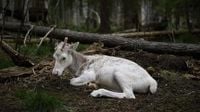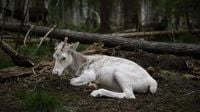High atop Luossavaara Mountain in northern Sweden, Sami reindeer herder Lars-Marcus Kuhmunen looks out over a landscape that has sustained his people for generations. But today, he sees a future clouded by uncertainty and loss. On September 7, 2025, Kuhmunen and other Indigenous Sami herders are facing a dual threat: the expansion of the world’s largest underground iron-ore mine at Kiirunavaara and the looming prospect of a new rare-earth mineral mine at the Per Geijer deposit—hailed as Europe’s largest. Together, these projects are fragmenting the land and threatening to sever ancient reindeer migration routes that are the backbone of Sami culture.
For the Sami village of Gabna, some 200 kilometers above the Arctic Circle, the stakes could not be higher. The community oversees between 2,500 and 3,000 reindeer, with 15 to 20 herders supporting around 150 people. Reindeer herding is not just a livelihood for these families; it is the foundation of their food, language, and traditional knowledge of the mountains. "The reindeer is the fundamental base of the Sami culture in Sweden," Kuhmunen explained to the Associated Press. "Everything is founded around the reindeers: The food, the language, the knowledge of mountains. Everything is founded around the reindeer herding. If that ceases to exist, the Sami culture will also cease to exist."
The Sami, descended from a once-nomadic people whose territory stretches across northern Sweden, Norway, Finland, and the northwestern corner of Russia, have faced centuries of external pressures. Until the 1960s, Swedish church and state authorities actively suppressed their language and herding traditions. Even today, Sami villages, or samebyar, are business entities tightly regulated by the state, which dictates how many semi-domesticated reindeer each village can have and where they can roam. There are at least 20,000 people with Sami heritage in Sweden, though official numbers are elusive due to legal prohibitions on ethnicity-based censuses.
Now, the survival of this culture is threatened by industrial ambitions and the accelerating effects of climate change. The Per Geijer mine, which Swedish officials and the state-owned mining company LKAB hope to open in the 2030s, is seen as a potential game-changer for Europe’s supply of rare-earth minerals. These minerals are essential components in everything from smartphones and hard drives to electric and hybrid vehicles, and their extraction is considered key for moving Europe away from fossil fuels and reducing dependence on China. "There are potential things that we can do and we can explore and we have to keep engaging," Darren Wilson, LKAB’s senior vice president of special products, told the Associated Press. "But I’m not underestimating the challenge of doing that."
Yet for Kuhmunen and his community, the economic and strategic arguments ring hollow in the face of existential loss. The expansion of Kiirunavaara has already forced Gabna’s herders to lead their reindeer along longer, more arduous migration routes. If the Per Geijer mine goes forward, Kuhmunen warns, it could cut off the last remaining migration paths between the summer mountains and the winter pastures rich in lichen—an essential food for the herds. "If the Per Geijer mine goes ahead, there will be no routes left for us to take our reindeer to the grazing grounds," Kuhmunen said. "That would be the end of the Indigenous way of life for me, my children, and our fellow Sami reindeer herders."
Compounding these pressures is the rapid warming of the Arctic, which scientists report is occurring four times faster than the global average. According to Anna Skarin, a reindeer husbandry expert at the Swedish University of Agricultural Sciences, the warming climate is wreaking havoc on traditional herding. Winters that once brought reliable snow now often bring rain, which freezes into ice and traps lichen beneath a hard crust, making it inaccessible to hungry reindeer. In the summer, temperatures have soared to 30 degrees Celsius (86 Fahrenheit), causing the animals to overheat and graze less, leaving them ill-prepared for the harsh winter months.
Some have proposed trucking reindeer between grazing areas if the mine is built, but experts and herders alike dismiss the idea as impractical. Reindeer need to graze while moving, and being transported by truck would deprive them of essential forage. "So you’re kind of both taking away the migration route that they have used traditionally over hundreds and thousands of years," Skarin explained, "and you would also take away that forage resource that they should have used during that time."
The Gabna village plans to contest the mine in court, but Kuhmunen is realistic about their chances against the might of the mining industry. "It’s really difficult to fight a mine. They have all the resources, they have all the means. They have the money. We don’t have that," he said. "We only have our will to exist. To pass these grazing lands to our children."
The threat to Sami reindeer herding is not just about economics or land use. It is about the potential erasure of a culture that has endured for thousands of years. "How can you tell your people that what we’re doing now, it will cease to exist in the near future?" Kuhmunen asked, voicing a fear shared by many in his community.
Swedish officials and LKAB maintain that the Per Geijer mine could help secure Europe’s technological future and support the global shift to renewable energy. But the Sami herders see a future where their traditions, language, and identity are sacrificed for minerals destined for distant factories. The balance between economic development and cultural preservation has rarely been so stark—or so urgent.
As the Arctic landscape continues to change, the Sami’s struggle has become a microcosm of a broader global dilemma: How do we weigh the needs of technological progress and energy transition against the rights and survival of Indigenous peoples? The Gabna herders’ fight to preserve their migration routes is not just about saving a way of life—it is about protecting a living link to the land and a culture that has adapted to its rhythms for millennia.
The outcome of this struggle remains uncertain. What is clear is that the Sami, with their deep knowledge of the mountains and their enduring will to exist, will not give up their heritage without a fight.





